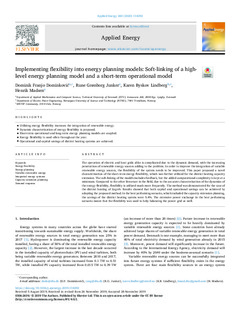| dc.contributor.author | Dominkovic, Dominik Franjo | |
| dc.contributor.author | Junker, Rune Grønborg | |
| dc.contributor.author | Lindberg, Karen Byskov | |
| dc.contributor.author | Madsen, Henrik | |
| dc.date.accessioned | 2019-12-16T06:43:43Z | |
| dc.date.available | 2019-12-16T06:43:43Z | |
| dc.date.created | 2019-12-11T11:09:34Z | |
| dc.date.issued | 2020 | |
| dc.identifier.issn | 0306-2619 | |
| dc.identifier.uri | http://hdl.handle.net/11250/2633299 | |
| dc.description.abstract | The operation of electric and heat grids alike is complicated due to the dynamic demand, with the increasing penetration of renewable energy sources adding to the problem. In order to improve the integration of variable renewable energy sources, the flexibility of the system needs to be improved. This paper proposed a novel characterization of the short-term energy flexibility, which was further utilized for the district heating capacity extension. The soft-linking of the models includes feedback, but the added computational complexity is kept at a minimum. Compared to the other literature in the field, due to the accurate characterization of the dynamics of the energy flexibility, flexibility is utilized much more frequently. The method was demonstrated for the case of the district heating of Zagreb. Results showed that both capital and operational savings can be achieved by adopting the proposed method. In the best performing scenario, which included the capacity extension planning, the savings of the district heating system were 5.4%. The extensive power exchange in the best performing scenario meant that the flexibility was used to help balancing the power grid as well. | nb_NO |
| dc.language.iso | eng | |
| dc.publisher | Elsevier | |
| dc.rights | CC BY 4.0 | |
| dc.rights.uri | http://creativecommons.org/licenses/BY/4.0/ | |
| dc.subject | Fleksibilitet | |
| dc.subject | Flexibility | |
| dc.subject | Fjernvarme | |
| dc.subject | District heating | |
| dc.subject | Fornybare energikilder | |
| dc.subject | Renewable energy | |
| dc.subject | Energy flexibility | |
| dc.subject | Energy planning | |
| dc.subject | Variable renewable energy | |
| dc.subject | Integrated energy systems | |
| dc.subject | Capacity extension planning | |
| dc.subject | Demand response | |
| dc.title | Implementing flexibility into energy planning models : Soft-linking of a high- level energy planning model and a short-term operational model. | |
| dc.type | Journal article | |
| dc.type | Peer reviewed | |
| dc.description.version | publishedVersion | |
| dc.rights.holder | © 2019 The authors | |
| dc.subject.nsi | VDP::Elkraft: 542 | |
| dc.subject.nsi | VDP::Electrical power engineering: 542 | |
| dc.source.pagenumber | 13 | |
| dc.source.volume | 260 | |
| dc.source.journal | Applied Energy | |
| dc.source.issue | 114292 | |
| dc.identifier.doi | 10.1016/j.apenergy.2019.114292 | |
| dc.identifier.cristin | 1759199 | |
| cristin.unitcode | 7401,30,0,0 | |
| cristin.unitname | SINTEF Community | |
| cristin.ispublished | true | |
| cristin.fulltext | original | |
| cristin.qualitycode | 1 | |

